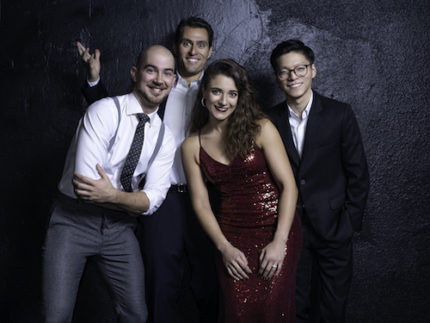Dover Quartet returns with polish, expressive intensity intact

According to the first line of their bio, the Dover Quartet was named one of the greatest string quartets of the last 100 years by BBC Music Magazine. Monday night’s concert at Northwestern University in Evanston proved just why they earned that moniker.
In this concert, rescheduled from the Winter Chamber Music Festival, the Bienen School of Music’s quartet-in-residence presented a stunning program of quartets by Haydn, Shostakovich, and Mendelssohn, united by the common key of D major.
The perfectly engineered acoustic of Pick-Staiger Concert Hall on the Northwestern campus highlighted the Dover Quartet’s studio-quality balance and precision. Each player knew their place within the larger context at all times so that every important detail was brought out seamlessly. Their intonation was consistently impeccable, and their playing was beautifully nuanced, but never to the point of preciousness.
The concert began with Haydn’s Quartet, Op. 64, no. 5, (“The Lark”). First violinist Joel Link brought an appropriately bird-like singing quality to the opening theme. In the expressive Adagio, the quieter moments were perfectly poised, while the two violins brought a meaty tone to the dense middle section as they played in the lower registers.
A visually engaging performer, Link leaned into his soloistic role throughout the Haydn quartet. His phrasing in the Adagio was exquisite, and the rapid stream of relentless sixteenth notes in the finale well controlled and musically shaped. The excitingly fast tempo of the finale quickened the adrenaline, albeit at the risk of slightly obscuring details in the fugal section. Nonetheless, it was executed flawlessly and proved an electrifying conclusion.
The Dover Quartet’s performance of Shostakovich’s String Quartet No. 4, Op. 83 provided an astonishing range of emotions and musical colors. As stated in the program note, the prevailing sentiment in the Fourth Quartet is “restraint verging on repression,” though intense emotions erupt through the surface at key moments.
The ensemble paced these tiered emotions well throughout, keeping the lid on during quieter moments to heighten the outbursts of agony and maniacal cheerfulness. This was especially apparent in the Andantino, which begins in a mood of doleful introspection. Eventually, the underlying frustration erupts into cacophonous wails of grief, with each instrument climbing higher and higher in register before collapsing into muted sorrow.
Shostakovich’s quartet provided more soloistic opportunities for each of the instruments than the Haydn. One stand-out moment came with violist Milena Pajaro-van de Stadt’s poignant solo bridging the Allegretto and the attacca Finale. Unaccompanied but for a few pizzicati, Pajara-van de Stadt’s translucent tone effectively captured the sense of resignation that permeates the piece. Similarly, the quartet ends not with a bang, but with a whimper, as cellist Camden Shaw closed out the piece with an impossibly delicate solo like the final wisp of breath leaving the body.
The opening movement of Mendelssohn’s String Quartet No. 3, Op. 44, no. 1 was a burst of sunlight after the intense Shostakovich quartet. The players were visibly more relaxed given the relatively lessened technical and emotional demands, but they never sacrificed musical nuance or precision. The recapitulation of the opening theme was especially exuberant, the quartet easily achieving the movement’s rich orchestral sonorities cited in the program notes.
Link became even more animated in his physical expressiveness, particularly in his liquid stream of eight notes in the trio section of the Menuetto and in his heart-wrenching cadenza in the Andante followed by an unflappably even extended trill. Though not nearly as much of showman as Link, second violinist Bryan Lee was a quiet, steadying force throughout, particularly in his winding countermelody of staccato sixteenth notes in the Andante. Cellist Shaw was demurely expressive and the most visually communicative of the four.
Northwestern is truly fortunate to have this world-class ensemble in residence, and the audience was lucky that they managed to reschedule this concert amid the Dover Quartet’s undoubtedly busy performing schedule.
Posted in Uncategorized




